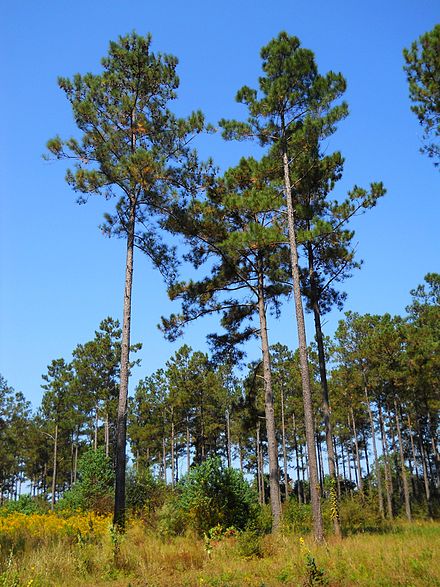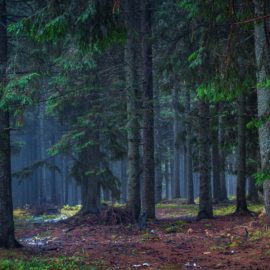
An ecosystem needs all of its parts to work. For example, take away trees and a lot is lost from tree cover, to nesting areas, to brush on the ground. That is happening throughout the South.
Rosie Tran fondly remembers the comfort she felt when she spent time in the forest at Camp Whispering Pines as a child. She recalls the sharp sweetness of its piney smell, and how the forest carried her imagination to a place that felt far away from her native south Louisiana. “It feels more isolated, secluded – more natural,” Ms. Tran says. “In Louisiana, the cypress tree is associated with nature. … When you’re in the longleaf pine forest, it doesn’t feel like southern Louisiana at all.” Today, Ms. Tran, who spent many summers at Whispering Pines as a camper and then a counselor, seeks to preserve this now-threatened forest and the trees that are very much at home in this landscape.
csmonitor.com
Forests ranged throughout the south since the indigenous people were here before the Europeans arrived. They were part of life and were used but not controlled.
Before Europeans arrived in North America, longleaf pine forest blanketed some 141,000 square miles of land from modern-day southern Virginia to East Texas. That’s an area about nine-tenths the size of California. But by the 1980s, just 3% of it remained – including the enclave at Whispering Pines. Now that too is at risk. In June, citing budgetary concerns, the Girl Scouts Louisiana East announced its intention to sell the 600-acre camp property, opening its scarce old-growth forest to possible development. In response, Ms. Tran and others in a recently formed group, Friends of the Longleaf Pines, are raising funds to either buy the land or have it designated as a conservation area. This puts them on the front lines of a wider movement to preserve and expand longleaf pine forests, significant for both their biodiversity and their resilience to climate change. Slowly, the efforts are making progress. “The southern United States is what we call the wood basket for the United States and beyond,” says Kevin Potter, a landscape ecologist at North Carolina State University. Now, after periods of overharvesting, he says, “there’s an effort going into maintaining and restoring these stands.”

https://plants.ces.ncsu.edu/plants/pinus-taeda/
Some say they only hold the earth together but the ecosystem sees then as necessary.
Even amid rising concern for the environment, development-oriented attitudes run deep in the region. Tangipahoa Parish, near the forefoot of Louisiana’s boot, is a zoning-free municipality, so development projects get underway with few obstacles. It’s also the prospective location for solar-power farms, which would require cutting significant portions of the longleaf pine forest. Over the summer, Ms. Tran’s group raised just over $5,000 – quite a distance from its $950,000 goal. The efforts here are part of a broader global shift, as humankind adapts for an uncertain climate future. China, for example, has a 40-year, billion-tree planting project underway. India has vowed to replant a third of its total land by 2030. Ethiopia plans to plant 20 billion tree seedlings by 2024. Longleaf pines grow tall and strong, seemingly reaching for the clouds as their needles and cones blanket the forest floor. When undisturbed, they can live up to 300 years, with trunks 100 feet tall and 3 feet wide, according to the National Wildlife Federation. An assortment of creatures use the longleaf pines to build their homes, and depend on the tree’s natural resistance to drought, wind, disease, and fire. Species that have been federally designated as endangered, like the red-cockaded woodpecker, eastern indigo snake, and gopher tortoise, once thrived in the ecosystems that longleaf pines sustained – as did other native species like wild turkey and bobwhite quail. The importance of habitat preservation was highlighted Wednesday, as the U.S. Fish and Wildlife Service declared 23 species of birds, fish, and other wildlife extinct – including the ivory-billed woodpecker, which lived in Southeastern swamps including in Louisiana. In the case of the longleaf pine, its decline relates to the very qualities of natural resilience that long sustained it.
Houses and building need structure and trees provided that. As we needed more buildings we needed more trees. But we did not conserve.
After the Civil War, the timber industry boomed, allowing for the development of both towns and local economies in rural areas across Texas, Louisiana, Mississippi, and beyond. “The South is the source of most of the pulp that we use for our paper and, to some degree, the wood that we use to build our houses,” says Dr. Potter, a biodiversity expert who researches the longleaf pine.
Then the need for trees raised the question of how can we sustain our use with out replenishment.
Beginning in the 1930s, with funding from the New Deal, reforestation efforts built national and state parks and replanted thousands of acres of forests in the southeast U.S., but they did not restore the longleaf pine. At the time, foresters set out to find a tree that was adaptive to a variety of soil conditions, and, to reinvigorate the timber industry, they also sought a species that grows fast. The resulting planting projects focused largely on the loblolly pine. These factors developed into a sort of myopia when it comes to reforesting efforts. Modern foresters still focus much of their research, training, and cultivation on the loblolly, effectively boxing out the slower-growing longleaf pine. “The system’s just kind of built around” the loblolly, says Chris Erwin, a native Alabaman and the director of Southern forest conservation at the American Forest Foundation. “It’s not anything malicious.” With a wink, he adds that it’s a matter of “not seeing the forest for the trees.” In fact, the longleaf pine isn’t exactly slow-growing. In the early years of a longleaf sapling’s life, most of its growth occurs underground; the trees develop their deep taproots first, which give them the resilience against wind, fire, and drought that may prove vital amid the climate crisis. And because the longleaf pine is native to the region, it provides better-suited habitat for native creatures, compared with the loblolly. “Fundamentally, longleaf pine is not about restoring it, locking it up in a museum, and setting it aside so nobody touches it and only photographs it,” says Dale Brockway, a researcher at the U.S. Department of Agriculture who studies forest ecosystem ecology and restoration. “It’s really about having a dynamic system that is completely functional, supports a wide variety of species with rich diversity, and provides opportunities for humans to interact with the system in a way where they can periodically extract sustainable levels.”

https://en.wikipedia.org/wiki/Pinus_taeda
The long leafed pine is coming back.
In 1995, environmental advocates say, the first hint at momentum in restoring the longleaf pine’s population began to take root with the establishment of the Longleaf Alliance, an organization dedicated to creating partnerships between private landowners and those interested in restoring the longleaf pines. Today, there are roughly 4.7 million acres of longleaf pine across the Southern landscape, up from a historic low of just more than 3 million in the early 1990s, according to America’s Longleaf Restoration Initiative’s 2020 accomplishment report. In fact, about a quarter of today’s longleaf population has been planted since 2010.
When I transferred from Miami to Washington D.C. I called the trip National Parks 101 as we visited as lot of them. To get to a park you go through a National Forest. With out these forests I am convinces roads would be everywhere. We need trees, we need forests.



